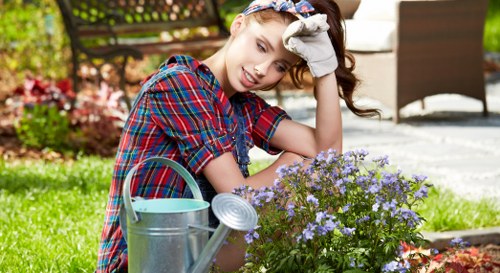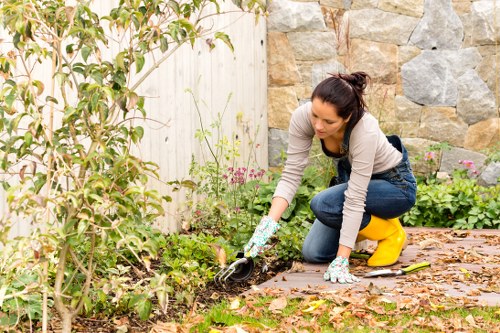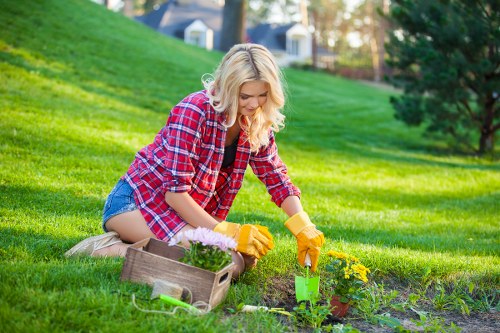Enhancing Outdoor Spaces: The Role of Garden Landscapers in a Gardening Company

Introduction to Garden Landscaping
Garden landscaping is an art and science that transforms ordinary outdoor spaces into stunning, functional environments. Garden landscapers in a gardening company play a pivotal role in this transformation by combining creativity, technical skills, and knowledge of plants and materials.
These professionals assess the unique characteristics of each space, taking into account factors like soil quality, climate, and the client's preferences. Their goal is to create a harmonious balance between aesthetics and practicality, ensuring that the garden not only looks beautiful but also thrives.
Whether it's designing a serene backyard oasis, a vibrant flower garden, or a sustainable green space, garden landscapers bring their expertise to every project. Their work enhances property values, provides a sanctuary for relaxation, and contributes to the overall well-being of the homeowners.

The Importance of Professional Garden Landscapers
Hiring professional garden landscapers from a reputable gardening company offers numerous benefits. These experts have the training and experience to handle various landscaping challenges, ensuring that the final result meets or exceeds expectations.
One of the key advantages is the personalized approach they take. Garden landscapers work closely with clients to understand their vision, preferences, and budget. This collaboration ensures that the design is tailored to the client's lifestyle and the specific conditions of the property.
Additionally, professional landscapers stay updated with the latest trends and sustainable practices. They can incorporate eco-friendly solutions, such as native plants and water-saving irrigation systems, into the design. This not only reduces maintenance costs but also promotes environmental responsibility.

Services Offered by Garden Landscapers
Garden landscapers in gardening companies offer a wide range of services to cater to diverse needs. Some of the primary services include:
- Landscape Design: Creating detailed plans that outline the layout, plant selection, and structural elements.
- Planting Services: Selecting and installing a variety of plants, trees, and shrubs that complement the design and thrive in the local climate.
- Hardscaping: Incorporating non-living elements like patios, walkways, fences, and water features to enhance functionality and aesthetics.
- Mowing and Maintenance: Regular upkeep to ensure the garden remains healthy and visually appealing.
- Lighting Installation: Adding outdoor lighting to highlight key features and provide safety during nighttime.

Choosing the Right Garden Landscaping Company
Selecting the right gardening company is crucial for achieving desired results. Here are some factors to consider:
- Experience and Expertise: Look for companies with a proven track record and diverse portfolio of projects.
- Customer Reviews: Testimonials and reviews can provide insights into the company's reliability and quality of work.
- Services Offered: Ensure the company offers the specific services you need for your garden.
- Budget: Discuss your budget upfront and choose a company that can work within your financial constraints.
- Communication: Effective communication is essential for understanding and executing your vision.

Trends in Garden Landscaping
Garden landscaping is continually evolving, with new trends emerging to meet changing preferences and environmental considerations. Current trends include:
- Sustainable Landscaping: Emphasizing the use of native plants, rainwater harvesting, and organic gardening practices.
- Outdoor Living Spaces: Creating areas for dining, lounging, and entertaining, often featuring furniture, fire pits, and outdoor kitchens.
- Vertical Gardening: Maximizing space by growing plants vertically on walls and fences.
- Smart Irrigation Systems: Utilizing technology to optimize water usage and reduce waste.
- Minimalist Designs: Focusing on clean lines, simple plant selections, and uncluttered spaces.
Staying updated with these trends allows garden landscapers to offer innovative solutions that meet the evolving needs of their clients.
Benefits of Professional Landscaping
Investing in professional landscaping brings numerous benefits, including:
- Increased Property Value: A well-designed garden enhances the curb appeal and overall value of your property.
- Improved Mental Health: Green spaces provide a tranquil environment that can reduce stress and promote relaxation.
- Environmental Benefits: Landscaped gardens contribute to biodiversity, improve air quality, and support local ecosystems.
- Energy Savings: Strategic placement of plants can provide natural insulation, reducing heating and cooling costs.
Maintenance Tips for Your Garden
Proper maintenance is essential to keep your garden healthy and vibrant. Here are some tips:
- Regular Watering: Ensure plants receive adequate water, especially during dry periods.
- Weeding: Remove weeds promptly to prevent them from competing with your plants for nutrients.
- Pruning: Trim overgrown plants to maintain their shape and promote healthy growth.
- Mulching: Apply mulch to retain moisture, suppress weeds, and improve soil quality.
- Fertilizing: Provide necessary nutrients to support plant growth and flowering.
Choosing the Right Plants
Selecting the appropriate plants is crucial for a successful garden. Consider factors such as:
- Climate Compatibility: Choose plants that thrive in your local climate and soil conditions.
- Sunlight Requirements: Ensure plants receive the right amount of sunlight, whether full sun, partial shade, or shade.
- Maintenance Level: Opt for low-maintenance plants if you prefer minimal upkeep.
- Color and Texture: Select a variety of plants to add visual interest and contrast.
- Bloom Time: Plant species that bloom at different times to ensure year-round beauty.
Consulting with professional garden landscapers can help you make informed decisions about plant selection.
Hardscaping Elements
Hardscaping refers to the non-living components of a garden, such as paths, walls, and structures. These elements add functionality and structure to the landscape.
Common hardscaping features include:
- Patios and Decks: Provide spaces for outdoor gatherings and relaxation.
- Walkways: Guide visitors through the garden and connect different areas.
- Retaining Walls: Help manage slopes and prevent soil erosion.
- Fences and Gates: Define property boundaries and enhance privacy.
- Water Features: Add aesthetic appeal with ponds, fountains, and waterfalls.
Integrating hardscaping elements with softscaping (plants) creates a balanced and cohesive garden design.
Seasonal Garden Care
Different seasons require specific care to maintain a healthy garden:
- Spring: Focus on planting new flowers, pruning, and preparing the garden for growth.
- Summer: Ensure adequate watering, manage pests, and deadhead spent blooms.
- Autumn: Clean up fallen leaves, mulch, and prepare plants for winter.
- Winter: Protect sensitive plants, plan for next year's garden, and maintain hardscaping features.
Professional garden landscapers can provide year-round maintenance services to keep your garden thriving.
Eco-Friendly Landscaping Practices
Embracing eco-friendly landscaping practices benefits both your garden and the environment:
- Native Plants: Use plants native to your region, which require less water and are more resistant to local pests.
- Rainwater Harvesting: Collect and utilize rainwater for irrigation, reducing reliance on municipal water sources.
- Composting: Recycle garden waste into nutrient-rich compost to enhance soil health.
- Permeable Paving: Install materials that allow water to seep through, reducing runoff and promoting groundwater recharge.
- Solar Lighting: Use solar-powered lights to illuminate your garden sustainably.
Implementing these practices creates a sustainable and resilient garden ecosystem.
Integrating Technology in Garden Landscaping
Modern technology has revolutionized garden landscaping, offering innovative solutions for design and maintenance:
- 3D Landscape Design Software: Visualize garden designs in three dimensions before implementation.
- Smart Irrigation Systems: Automate watering schedules based on weather forecasts and soil moisture levels.
- Drones: Assess large garden areas efficiently and plan layouts with aerial insights.
- Garden Sensors: Monitor plant health, humidity, and temperature to optimize growing conditions.
- Robotic Lawn Mowers: Maintain lawns with minimal human intervention.
Incorporating technology enhances the precision and efficiency of gardening projects, leading to better outcomes.
Creating a Personalized Garden
A personalized garden reflects the unique tastes and lifestyle of the homeowner. Garden landscapers work to incorporate individual preferences into the design:
- Theme-Based Designs: Choose themes like tropical, Mediterranean, or Japanese to guide plant and feature selection.
- Functional Areas: Designate spaces for specific activities, such as dining, gardening, or children's play areas.
- Artistic Elements: Add sculptures, murals, and decorative features to infuse personality into the garden.
- Color Schemes: Select color palettes that resonate with the homeowner's aesthetic preferences.
- Personal Touches: Incorporate elements like family heirlooms or favorite plants to make the garden truly unique.
Creating a personalized garden fosters a deeper connection between the homeowner and their outdoor space.
Winterizing Your Garden
Proper winterization ensures that your garden remains healthy during the colder months:
- Protecting Plants: Use coverings or mulches to shield plants from frost and harsh weather.
- Pruning: Trim dead or damaged branches to prevent disease and promote healthy growth in spring.
- Cleaning: Remove debris and clean garden tools to prevent rust and damage.
- Storage: Store delicate plants indoors or in a greenhouse to keep them safe from freezing temperatures.
- Maintenance of Hardscaping: Inspect and repair any damaged structures to ensure they withstand winter conditions.
Winterizing helps your garden recover and thrive when the growing season returns.
Maximizing Small Garden Spaces
Even small gardens can be transformed into beautiful and functional spaces with the right design strategies:
- Vertical Gardening: Utilize walls and fences to grow plants vertically, saving ground space.
- Multi-Functional Furniture: Choose furniture that serves multiple purposes, such as storage benches or foldable tables.
- Mirrors and Reflective Surfaces: Create the illusion of more space by reflecting light and greenery.
- Compact Plant Varieties: Select dwarf or compact plant species that fit well in limited spaces.
- Layered Planting: Arrange plants in layers to maximize coverage and visual interest.
With thoughtful planning, small gardens can offer just as much beauty and enjoyment as larger landscapes.
Enhancing Privacy in Your Garden
Creating a sense of privacy in your garden allows you to enjoy your outdoor space without disturbances:
- Hedges and Fences: Plant tall hedges or install fences to block views and reduce noise.
- Strategic Plant Placement: Position plants and structures to provide natural barriers.
- Privacy Screens: Use trellises, pergolas, or decorative screens to add layers of seclusion.
- Water Features: Incorporate fountains or ponds that mask ambient sounds and create a peaceful atmosphere.
- Outdoor Curtains: Install curtains or blinds on pergolas and gazebos for added coverage.
Enhancing privacy ensures that your garden remains a personal retreat.
Integrating Wildlife-Friendly Features
Promoting wildlife in your garden contributes to biodiversity and creates a lively ecosystem:
- Biodiverse Plant Selection: Choose a variety of plants that provide food and habitat for different species.
- Birdhouses and Feeders: Attract birds by providing nesting sites and food sources.
- Butterfly Gardens: Plant nectar-rich flowers to support butterfly populations.
- Bee-Friendly Plants: Incorporate plants that attract and support bees for pollination.
- Water Sources: Install birdbaths or small ponds to provide drinking water for wildlife.
Creating a wildlife-friendly garden enhances its natural beauty and ecological value.
Sustainable Garden Practices
Sustainability is a key consideration in modern garden landscaping. Sustainable practices not only benefit the environment but also ensure the longevity and resilience of your garden:
- Composting: Turn organic waste into nutrient-rich compost to improve soil health.
- Rain Gardens: Designate areas to capture and absorb rainwater, reducing runoff and replenishing groundwater.
- Perennial Plants: Plant perennials that return year after year, reducing the need for replanting.
- Organic Gardening: Avoid chemical fertilizers and pesticides, opting for natural alternatives.
- Energy-Efficient Lighting: Use LED or solar-powered lights to minimize energy consumption.
Implementing sustainable practices creates a garden that is both beautiful and environmentally responsible.
Conclusion: Transform Your Outdoor Space
Garden landscapers in a gardening company bring expertise and creativity to transform outdoor spaces into beautiful, functional, and sustainable environments. From design and planting to hardscaping and maintenance, their comprehensive services cater to diverse needs and preferences.
Investing in professional landscaping not only enhances the aesthetic appeal of your property but also contributes to your well-being and environmental sustainability. Embrace the opportunities that garden landscaping offers and create a personalized sanctuary that reflects your unique style.
Contact us today to start your garden transformation journey or book your service now to enjoy a stunning and thriving outdoor space.